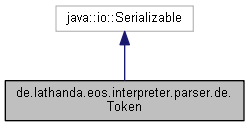 |
EOS 2
1.1.0
Einfache Objektbasierte Sprache
|
 |
EOS 2
1.1.0
Einfache Objektbasierte Sprache
|

Öffentliche Methoden | |
| Object | getValue () |
| Token () | |
| Token (int kind) | |
| Token (int kind, String image) | |
| String | toString () |
Öffentliche, statische Methoden | |
| static Token | newToken (int ofKind, String image) |
| static Token | newToken (int ofKind) |
Öffentliche Attribute | |
| int | kind |
| int | beginLine |
| int | beginColumn |
| int | endLine |
| int | endColumn |
| String | image |
| Token | next |
| Token | specialToken |
Describes the input token stream.
Definiert in Zeile 9 der Datei Token.java.
| de.lathanda.eos.interpreter.parser.de.Token.Token | ( | ) |
No-argument constructor
Definiert in Zeile 78 der Datei Token.java.
| de.lathanda.eos.interpreter.parser.de.Token.Token | ( | int | kind | ) |
Constructs a new token for the specified Image.
Definiert in Zeile 83 der Datei Token.java.
| de.lathanda.eos.interpreter.parser.de.Token.Token | ( | int | kind, |
| String | image | ||
| ) |
Constructs a new token for the specified Image and Kind.
Definiert in Zeile 91 der Datei Token.java.
| Object de.lathanda.eos.interpreter.parser.de.Token.getValue | ( | ) |
An optional attribute value of the Token. Tokens which are not used as syntactic sugar will often contain meaningful values that will be used later on by the compiler or interpreter. This attribute value is often different from the image. Any subclass of Token that actually wants to return a non-null value can override this method as appropriate.
Definiert in Zeile 71 der Datei Token.java.
|
static |
Definiert in Zeile 125 der Datei Token.java.
|
static |
Returns a new Token object, by default. However, if you want, you can create and return subclass objects based on the value of ofKind. Simply add the cases to the switch for all those special cases. For example, if you have a subclass of Token called IDToken that you want to create if ofKind is ID, simply add something like :
case MyParserConstants.ID : return new IDToken(ofKind, image);
to the following switch statement. Then you can cast matchedToken variable to the appropriate type and use sit in your lexical actions.
Definiert in Zeile 117 der Datei Token.java.
| String de.lathanda.eos.interpreter.parser.de.Token.toString | ( | ) |
Returns the image.
Definiert in Zeile 100 der Datei Token.java.
| int de.lathanda.eos.interpreter.parser.de.Token.beginColumn |
The column number of the first character of this Token.
Definiert in Zeile 28 der Datei Token.java.
| int de.lathanda.eos.interpreter.parser.de.Token.beginLine |
The line number of the first character of this Token.
Definiert in Zeile 26 der Datei Token.java.
| int de.lathanda.eos.interpreter.parser.de.Token.endColumn |
The column number of the last character of this Token.
Definiert in Zeile 32 der Datei Token.java.
| int de.lathanda.eos.interpreter.parser.de.Token.endLine |
The line number of the last character of this Token.
Definiert in Zeile 30 der Datei Token.java.
| String de.lathanda.eos.interpreter.parser.de.Token.image |
The string image of the token.
Definiert in Zeile 37 der Datei Token.java.
| int de.lathanda.eos.interpreter.parser.de.Token.kind |
An integer that describes the kind of this token. This numbering system is determined by JavaCCParser, and a table of these numbers is stored in the file ...Constants.java.
Definiert in Zeile 23 der Datei Token.java.
| Token de.lathanda.eos.interpreter.parser.de.Token.next |
A reference to the next regular (non-special) token from the input stream. If this is the last token from the input stream, or if the token manager has not read tokens beyond this one, this field is set to null. This is true only if this token is also a regular token. Otherwise, see below for a description of the contents of this field.
Definiert in Zeile 47 der Datei Token.java.
| Token de.lathanda.eos.interpreter.parser.de.Token.specialToken |
This field is used to access special tokens that occur prior to this token, but after the immediately preceding regular (non-special) token. If there are no such special tokens, this field is set to null. When there are more than one such special token, this field refers to the last of these special tokens, which in turn refers to the next previous special token through its specialToken field, and so on until the first special token (whose specialToken field is null). The next fields of special tokens refer to other special tokens that immediately follow it (without an intervening regular token). If there is no such token, this field is null.
Definiert in Zeile 61 der Datei Token.java.